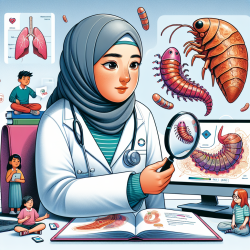Introduction
As a speech-language pathologist, understanding the broader health conditions that may affect a child's development is crucial. Recent research titled "A prognostic model for Schistosoma japonicum infection-associated liver hepatocellular carcinoma: strengthening the connection through initial biological experiments" provides insights that could indirectly influence our practice. Although the study focuses on liver cancer, the methodologies and findings can inspire further research and application in speech-language pathology, especially in data-driven decision-making and personalized care approaches.
Understanding the Research
The study explores the link between Schistosoma japonicum infection and liver hepatocellular carcinoma (LIHC). By identifying differentially expressed genes (DEGs) and constructing a prognostic model, the research sheds light on the genetic and molecular pathways involved in disease progression. This model is significant for predicting patient outcomes and tailoring individualized treatment plans.
Application in Speech-Language Pathology
While the direct application of this research to speech-language pathology might not be immediately apparent, there are several key takeaways that practitioners can leverage:
- Data-Driven Decisions: The use of bioinformatics and molecular biology analyses in the study emphasizes the importance of data-driven decisions. Speech-language pathologists can adopt similar methodologies by using comprehensive assessments and data analytics to tailor interventions for children with communication disorders.
- Personalized Care: The study's focus on individualized treatment plans aligns with the trend in speech-language pathology towards personalized interventions. Understanding the unique genetic and environmental factors affecting a child's communication can enhance therapy outcomes.
- Interdisciplinary Collaboration: The research highlights the value of interdisciplinary collaboration. Speech-language pathologists can benefit from working closely with other healthcare professionals to address complex cases, particularly when underlying health conditions like infections or genetic predispositions are involved.
Encouraging Further Research
The prognostic model developed in this study serves as a foundation for further research. Speech-language pathologists are encouraged to explore the potential genetic and environmental factors influencing communication disorders. Investigating how infections, like Schistosoma japonicum, might indirectly impact speech and language development could lead to new insights and interventions.
Conclusion
The research on Schistosoma japonicum infection and liver cancer provides valuable lessons for speech-language pathology. By embracing data-driven approaches, personalized care, and interdisciplinary collaboration, practitioners can enhance their skills and improve outcomes for children. To read the original research paper, please follow this link: A prognostic model for Schistosoma japonicum infection-associated liver hepatocellular carcinoma: strengthening the connection through initial biological experiments.










